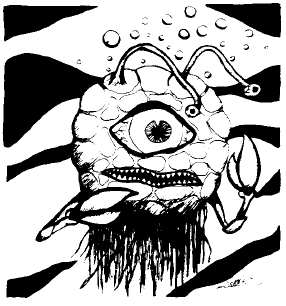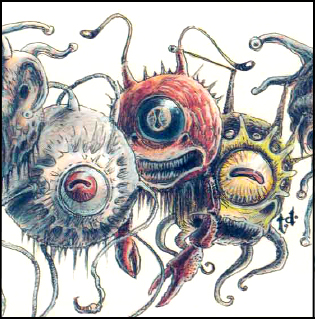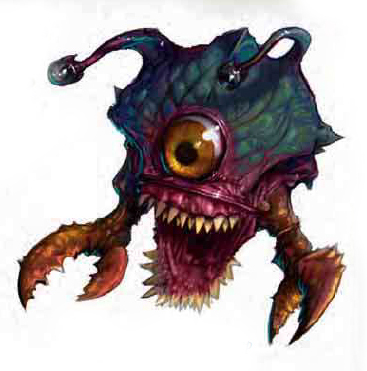Note: ‘Classic’ is a pretty subjective term, and when I use it here I mean to say: monsters that have survived through the editions of D&D that I think are cool. In this series of articles I look at the development of a classic monster over time and try to add a ‘crunchy’ piece of my own to the creature’s canon.
 The eye of the deep, the beholder’s unloved cousin, has long held a special fascination for me. As I’ve mentioned previously, when I was a kid who didn’t know any better, flipping through my older brother’s copy of the Monster Manual, this critter caught my eye. Until I had been playing the game for some time, I mistakenly believed that the eye of the deep was a more powerful version of the beholder, since it had eye rays and giant lobster claws (lobster claws were the tentacles of the eighties). Even when I had been properly schooled in D&D lore, my initial impressions of this monster insured it would regularly surface from my subconscious any time I found myself staring down into water that was too deep to see the bottom (well, the eye of the deep and those giant tube worms from the G.I. Joe episodes with the MASS device).
The eye of the deep, the beholder’s unloved cousin, has long held a special fascination for me. As I’ve mentioned previously, when I was a kid who didn’t know any better, flipping through my older brother’s copy of the Monster Manual, this critter caught my eye. Until I had been playing the game for some time, I mistakenly believed that the eye of the deep was a more powerful version of the beholder, since it had eye rays and giant lobster claws (lobster claws were the tentacles of the eighties). Even when I had been properly schooled in D&D lore, my initial impressions of this monster insured it would regularly surface from my subconscious any time I found myself staring down into water that was too deep to see the bottom (well, the eye of the deep and those giant tube worms from the G.I. Joe episodes with the MASS device).
I admit, I’ve never used the eye of the deep in a game. I’m not really sure why. It could have been because I’ve never ran a game that focused on water encounters. Or it could be because(as far as I’m aware), the eye of the deep was never used in a single published adventure, not even in 2nd edition’s monstrous arcana series focused on beholders and beholder-kin (Eye of Pain, Eye of Doom, and Eye to Eye). Then again, it took until 3.5 edition for me to use a regular beholder in an encounter (and no one would argue with its icon status), so I hardly think that’s a strike against it.
Possible Origins?
This is a bit of a non sequitur in an already long article, but I’ve always wondered if the character of Alpha Centauri from Doctor Who had anything to do with the inspiration for the eye of the deep. It does resemble the creature, and it did air in the Curse of Peladon serial in 1972, 5 years before the eye’s appearance in D&D.
1st Edition
While the beholder made its debut in the pages of the Greyhawk supplement for OD&D, the eye of the deep didn’t make it into the game until 1977’s Monster Manual. It has the distinction of being the very first in a long line of beholder variants the game acquired over the years. The book establishes the eye of the deep as a 3-5 foot diameter sphere (size large in AD&D), with a pair of crab-like pincers, a large central eye and a pair of eyestalks. The main eye can emit a blinding flash that stuns opponents, while the smaller eyes can work together to create illusions or cast hold monster and hold person independently.
In Dragon Magazine’s The Ecology of the Eye of the Deep, none other than Ed Greenwood expands on the creature’s lore. The meat of the article describes the creature’s reproductive cycle (they’re hermaphrodites), its hunting habits (it uses its illusion powers to lure prey close and then stuns them with its central eye), and even scientific tidbits about its physiology (the eye of the deep cannot rise to the surface without the change in pressure causing it to explode). Greenwood also adds to the eye of the deep’s attacks, giving it the ability to grab onto opponents with its claws.
 2nd Edition
2nd Edition
The eye of the deep next appears in 2nd edition D&D’s first volume of the Monstrous Compendium. Here it is presented as a variant of the beholder, but is otherwise almost identical to its AD&D version (although its size remains 3-5 feet in diameter, in this version of the game that makes it a small-medium size creature). Ed Greenwood’s grasping claw attack is not incorporated into the monster’s statistic block.
Late in the edition’s lifespan we are given another glimpse of the eye of the deep in the monstrous arcana supplement, I Tyrant. Although the creature gets only a short paragraph in the book, author Aaron Allston gives us a glimpse of the eye of the deep’s sociology: they communicate over long distances using the light flash from their central eye, and teach their offspring how to hunt using their ability to generate illusions (although this doesn’t really fit with Greenwood’s depiction of them randomly leaving eggs on the sea floor).
3rd Edition
 The eye of the deep isn’t updated until 3.5 edition’s Lords of Madness hardcover. In this incarnation the eye retains the ability to stun and blind with its central eye, hold monster, generate illusions, and even grab hold with its claws. It loses the ability to hold person (which makes sense since hold monster supersedes that ability in this edition), but gains the power to project a cone of cold. This edition also sees the first real size change in the creature, growing to a nine foot diameter, 6000 pound behemoth (large sized with the option to advance in hit dice to huge size).
The eye of the deep isn’t updated until 3.5 edition’s Lords of Madness hardcover. In this incarnation the eye retains the ability to stun and blind with its central eye, hold monster, generate illusions, and even grab hold with its claws. It loses the ability to hold person (which makes sense since hold monster supersedes that ability in this edition), but gains the power to project a cone of cold. This edition also sees the first real size change in the creature, growing to a nine foot diameter, 6000 pound behemoth (large sized with the option to advance in hit dice to huge size).
The behaviour of the eye of the deep generally conforms to previous editions (it uses illusions to lure and confuse prey), but the authors (Richard Baker, James Jacobs and Steven Winter) made one alteration that I think illustrates the changing philosophy of D&D game design. Instead of keeping a solitary vigil over shipwrecks at the bottom of the ocean (and exploding if it ascends), the Lords of Madness eye of the deep prefers to hunt on the surface. While this approach may be less realistic (we are talking about a giant floating eye with claws) than Greenwood’s, it’s a change that puts the monster in immediate and direct conflict with the PCs and thus makes it much more useful for DMs.
4th Edition
 It seems that the only legacy of this monster to penetrate the 4th edition of D&D has been the ‘eye of’ naming convention. Then again, the eye of the deep has not been singled out in its exclusion. It seems that the long list of beholder-kin from previous editions is one of the ‘sacred cows’ the designers of the game wished to slay. It seems though, that a long list of beholder variants isn’t what the designers had a problem with per se (the compendium currently holds 17 different variety of the monster). So I guess it was the specific variants themselves they didn’t like (some of them were pretty silly – I’m looking at you director)… Or maybe they just wanted to create something new. Regardless, I can’t let the snubbing of one of my favourite beasties stand, so I present to you this unofficial entry into 4th edition canon:
It seems that the only legacy of this monster to penetrate the 4th edition of D&D has been the ‘eye of’ naming convention. Then again, the eye of the deep has not been singled out in its exclusion. It seems that the long list of beholder-kin from previous editions is one of the ‘sacred cows’ the designers of the game wished to slay. It seems though, that a long list of beholder variants isn’t what the designers had a problem with per se (the compendium currently holds 17 different variety of the monster). So I guess it was the specific variants themselves they didn’t like (some of them were pretty silly – I’m looking at you director)… Or maybe they just wanted to create something new. Regardless, I can’t let the snubbing of one of my favourite beasties stand, so I present to you this unofficial entry into 4th edition canon:
Beholder Eye of the Deep
Not all beholders dwell in the twisted passages of the underdark. Some float in the lightless ocean depths, rising to the surface to terrorize and destroy any that dare cross their invisible territories.
Lore
Dungeoneering DC 15: Though they lack the sheer number of eye rays that other beholders possess, the eye of the deep compensates by way of strong grasping claws and the ability to generate illusions.
Encounters
Beholders are rarely willing to serve other creatures, and the eye of the deep is no exception. However, some eyes of the deep bully nearby sahuagin into servitude, using them as shock troops to subdue passing ships and coastal towns. The eye of the deep is a negligent master though, and over time the sahuagin invariably desert, fall in combat, or are eaten for food.
Eye of the Deep in Combat
The eye of the deep takes great pleasure in creating illusions to lure its prey in close. The cruel beasts create images of shipwreck survivors, mermaids, and anything else they think will draw their targets into the water. The eye of the deep always opens combat with a stunning blast of light from its central eye before ripping its helpless victim into digestible hunks with its claws.
Tags: 4e, Blather, D&D, Old-School
I just realized in the creature’s traits it should have a +1 to hit grabbed targets, not bloodied ones… If I develop a cure for laziness I’ll correct it 🙂
No cure for laziness yet, but I did correct the eye of the deep.
Pingback: Random Encounters: Put on a Grey Ribbon « Ménage à Monster